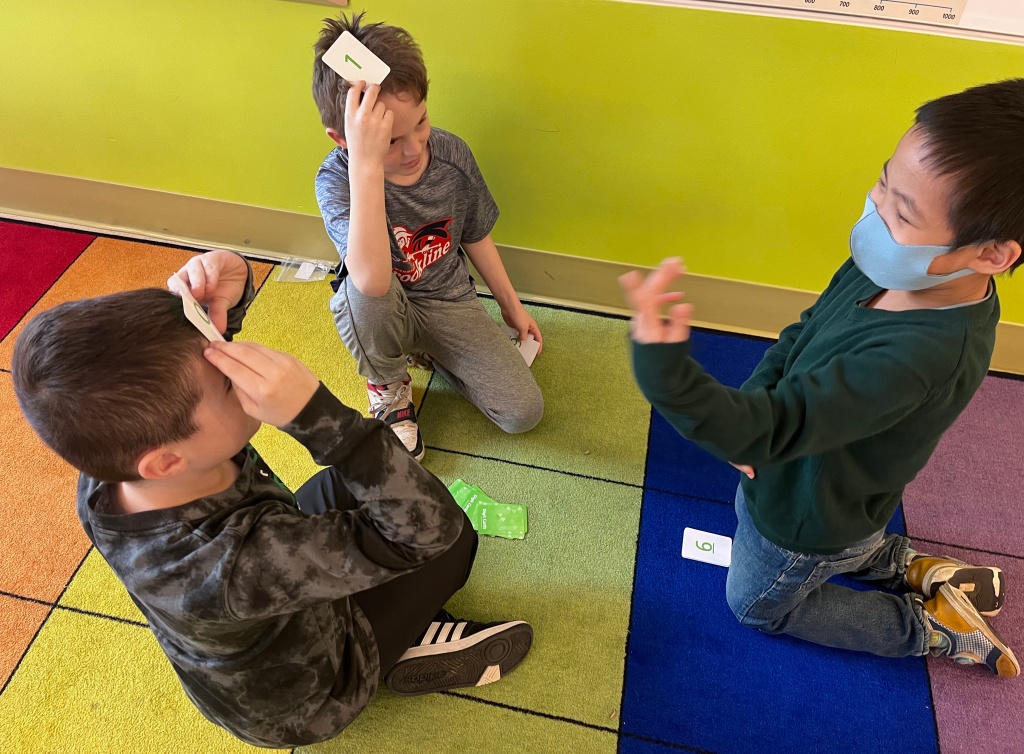In a third grade class, students were in triads playing a game of “Headache,” which is sometimes called Salute. Two students place cards on their foreheads, facing out, and the third announces the product. The other two then look at their partner and figure out what their card must be.

Max was stuck. The product was zero, and his partner had a 0. “It’s not fair! Couldn’t my card be anything?”
“It’s a one,” his partner Liam explained.
“Yeah, but and also
. It’s not fair.”
I intervened: “I didn’t realize there were still 0s in that deck of cards! Max is right that it’s impossible for him to know what he has. Let’s remove the zeroes. ”
Division Dilemma
As I was wrapping up in that class, the third grade teacher next door popped her head into the room. “Ms. Laib, if you have a minute, can you stop by my class? The kids have a question.”
My favorite! I love when teachers draw me in to their students’ mathematical dilemmas. Recently, I’ve had kindergartners ask me for the names of irregular shapes, and fourth graders ask me about why 1 is a prime number.
“So,” the teacher told me. “They were working on this division problem. And it has a zero.” I was intrigued.
“I think that 0 ÷ 4 is impossible,” third grader Jason told me. “You can’t divide by anything with zeroes.”
“But isn’t the answer zero?” Ahmed asked. “How can division be impossible?”
Ahhhh, the best kind of math dilemma: when everyone has something at least partially right! We can build from there.
More than ten years ago, my brother Ben wrote a blog post he called, “Why can’t you divide by zero?” (As as an aside, the ‘bad drawings’ in this vintage post are proof positive that you can get better at something with some combination of persistence, practice, and feedback. Ben’s current bad drawings are charming!) In the post, he outlined explanations from his wife Taryn, my father, and me (the mathematical lightweight of the family). I considered pulling up the blog post to validate the inquiry — “look! this is a question mathematicians think about!” — but that felt a little condescending, and beside the point. I wanted the class’ takeaway to be more than “wow, you think about things that other people think about.” I decided that I’d go at it with nothing but a whiteboard.
Using a Story Context
I wrote the following on the board:
“Let’s tell a division story in order to understand what’s happening here,” I prompted. “But it can be a little hard to focus on both the story AND what the zeroes mean, so let’s tell it about another problem, like .
Four students immediately raised their hand, but then slowly put it back down shortly after we made eye contact, like a military retreating. I called on one of them anyway. “Ainsley? Do you have a story?”
“Oh, no….” she trailed off.
I called on Sasha.
“Okay, so there are 6 apples, and you share them with you and a friend,” Sasha stated confidently.
“Oh! Okay, so the six is how many apples we have in all…” I recorded ‘6 apples’ on the board. “And then you and a friend… is that two people? So it’s 6 apples shared among 2 people?”
Sasha nodded enthusiastically, and I wrote “6 apples shared by 2 people” on the board.
“And it’s three,” Belle added.
“Yes! . What does the 3 tells us?”
“Three is how much they each get,” Belle continued, as I transcribed for the board.
6 apples shared by 2 people means each person gets 3 apples
“Let’s try using Sasha’s story, but with new numbers.” I used my hand to erase the numbers in the original story. “4 apples shared by 0 people means each person gets…”
I heard a few kids calling out zero! But also four! We were losing the thread of my argument.
“It’s a little confusing, right? Let’s try the next one. 0 apples shared by 4 people means each person gets…”
The students offered a chorus of zero in such unison that you’d think they were facing a master conductor.
“Yes! It’s like if I have zero dollars — no money — and I offer to give 4 people equal shares, everyone gets nothing. I could share my zero dollars with all of you, in fact. I’m very generous.” I could feel the class starting to drift. “This is the division property of zero. I can share my zero dollars with everyone in the world, or just one person, and the amount per person will always be zero.”
“So you can divide by zero?” Jason asked, a little crestfallen. He averted his eyes.
“Well, we divided zero by another number! Let’s return to dividing by zero. Jason, I think you’re going to like this,” I said, selecting another color marker, and sincerely hoping I had not already crushed Jason’s spirits. It can be hard to find out you’re wrong in front of the class. It’s also something I want to normalize. It’s okay to revise our thinking. In fact, it’s beautiful when we revise our thinking.
“4 apples shared by 0 people means everyone gets…”
Arya wrinkled her noses in confusion. Matteo looked towards the ceiling, avoiding my gaze. Students did not know what to do with this.
“Yeah, it doesn’t make a lot of sense, does it? Like how can I give apples to nobody. And each nobody gets the same amount? They don’t exist.”
This wasn’t helping. I decided to try a second argument — the one I had offered in Ben’s blog post.
Using Inverse Operations
“So ,” I started. “It’s also true that 2 people with three apples each means that there are 6 apples in all.
. As you know from the unit we just finished, multiplication and division are inverse operations.”
“They undo eachother,” the teacher added.
“Yes! So let me color code those numbers to show the relationship,” I said as I drew an orange box around the 6s, and then switched to blue for the 2s and green for the 3s. “Now let’s try doing that same thing for our division with zero problems.”
I decided we’d start with the more straightforward problem: . I called on a student to write the related multiplication problem:
“Oh, that’s easy,” Emma said. “It’s zero.”
“And it can only be zero,” I said.
“Now let’s try it with the other problem.”
As I scanned the array of desks, I saw those same signs of confusion: pursed lips, wrinkled noses, students anxiously looking away. But this time, I was fine with it.
“Precisely,” I said. “Many of you look confused, and that’s because it is impossible.”
Jason raised a triumphant fist. “I knew it!”
“No matter how many groups of 0 apples we have, we will never have 4. It’ll just keep being zero. In mathematics, we use the fancy term undefined to describe the answer to something divided by zero.” I said. I saw the color return to Matteo’s face. Relief. I crossed out the box.
The Important Thing About…
“I have to get going to 8th grade,” I told the class, “but I wanted to say… it’s great if you remember that you can divide zero by a number, but not a number by zero. However, here’s what I really want you to take away from this:
- You can try out a story problem to see if numbers make sense.
- You can use inverse operations to check whether something makes sense.
This will be important when you’re dealing with adding and subtracting and multiplying and dividing with other numbers as you get older, like fractions and,” with a dramatic gasp, “negative numbers.”
“YES!” Jason was pumped.
“So that’s what I want you to remember. Try a story problem. Use inverse operations. These are your tools that you can use to see if something makes sense. And I think you can all do this: rely on what math ideas you already have to figure out if new math ideas make sense.”
What will students remember?
Every math teacher has had to stifle a groan when asked “why do we need to know this?” Like… ugh. But sometimes, it’s helpful for me to think about what I want students to take away from a learning experience.
Sometimes it really is important to know the thing. I really want students to be able to name equivalent fractions. This is an important skill across many domains.
And sometimes, it’s important for students to know the process. It may become essential for these students to know that dividing by zero is undefined in the future. Re-figuring it out using inverse operations may tax their working memory when they’re high schoolers in Algebra 2. However, as third graders, it’s more important to remember that we can leverage what we know to explore new ideas. The second strategy I gave — using inverse operations — was more elegant and clear than the initial “try a story problem” route we had taken. (It was also how I explained dividing by zero in Ben’s blog post.) However, I don’t regret showing them both pathways. It can seem magical when someone with greater content knowledge comes in and easily solves or explains something. How did they know to go there? Did they wave a wand? Here, the students saw me try out two different things, it reveals more of the process.
Time will tell if this conversation has any impact on the students. Maybe some of them will only remember that teachers get excited about what they have to say, and their ideas matter! Many of them will forget the entire exchange. We can’t control what happens for every students, but the accumulation of these experiences — honoring their questions, asking them for input, trying to make sense of new ideas — is much more likely to shape how students think mathematically.


1 Comment